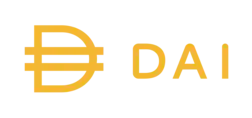Dai (cryptocurrency)
Dai (or DAI) is a stablecoin cryptocurrency which aims to keep its value as close to one United States dollar (USD) as possible through an automated system of smart contracts on the Ethereum blockchain. Dai is maintained and regulated by MakerDAO, a decentralized autonomous organization (DAO) composed of the owners of its governance token, MKR, who may vote on changes to certain parameters in its smart contracts in order to ensure the stability of Dai.[2][3]
| Dai | |
|---|---|
 | |
| Denominations | |
| Plural | Dai |
| Ticker symbol | DAI |
| Previous names | Sai |
| Precision | 10-18 |
| Development | |
| White paper | makerdao |
| Initial release | December 18, 2017 |
| Code repository | github |
| Written in | Solidity |
| Operating system | Ethereum |
| Developer(s) | Maker Foundation |
| Source model | Open source |
| License | AGPL v3.0 |
| Website | makerdao |
| Ledger | |
| Circulating supply | 1,405,160,705 DAI (February 2021)[lower-alpha 1] |
| Supply limit | None |
| Valuation | |
| Exchange rate | $1.00 USD |
Together, Dai and MakerDAO are considered the first examples of decentralized finance to receive significant adoption.[4]
Overview
Dai is created from an overcollateralized loan and repayment process facilitated by MakerDAO's smart contracts in the form of a decentralized application. Users who deposit Ether (or other cryptocurrencies accepted as collateral) are able to borrow against the value of their deposits and receive newly generated Dai. The collateralization ratio for Ether is currently set at 150%, or in other words, depositing $150 worth of Ether allows one to borrow up to 100 Dai (roughly equivalent to $100). If the value of the collateral declines below this ratio, the loan can be automatically liquidated by the smart contracts. On the other hand, if its value increases, additional Dai can be borrowed.[3][5]
Consequently by repaying a loan and its accrued interest, the returned Dai is automatically destroyed and the collateral is made available for withdrawal. In this way the USD value of Dai can be said to be backed by the USD value of the underlying collateral held by MakerDAO's smart contracts.[6] By controlling the types of accepted collateral, collateralization ratios, and the interest rates for borrowing or storing Dai, MakerDAO is able to control the amount of Dai in circulation, and thus its value.[7]
The power to propose and implement changes to such variables is granted, through code, to holders of the MKR token. Owners of the governance token are able to vote on proposed modifications in equal proportion to the amount of tokens they hold. The MKR token also serves as an investment in the MakerDAO system. Added interest that borrowers pay back, on top of their loan's principal, is used to buy up MKR tokens from the market and burn them (i.e. destroy, permanently take out of circulation). This mechanism aims to make MKR deflationary in correlation to the revenues from lending Dai.[5][7]
History
MakerDAO was formed in 2014 by Danish entrepreneur Rune Christenson.[5]
On December 18, 2017, Dai and its associated smart contracts were officially launched on the main Ethereum network.[5][8] The price of Dai was successfully kept close to one US dollar during its first year of existence, even though the price of Ether, the only collateral available at the time, declined by more than 80% during the same time period.[7]
In September 2018, venture capital firm Andreessen Horowitz invested $15 million in MakerDAO by purchasing 6% of all MKR tokens.[7]
In 2018, MakerDAO formed the Maker Foundation, run from Copenhagen, which serves to help bootstrap the ecosystem by, for example, writing code needed for the platform to function and adapt.[9]
In 2019, MakerDAO experienced internal struggle over whether it should integrate more with the traditional financial system. Christenson wanted greater regulatory compliance to allow for assets besides cryptocurrency to serve as collateral for Dai. The struggle led to the departure of MakerDAO's CTO.[5]
In March 2020, as a result of extraordinary market volatility at the onset of the COVID-19 pandemic, Dai experienced a deflationary deleveraging spiral that, at its peak, caused it to trade for up to USD $1.11[lower-alpha 1] before returning to its intended $1.00 valuation.[10]
Notes
- According to data provided by CoinMarketCap.[1]
References
- "Dai price today, DAI marketcap, chart, and info". CoinMarketCap. Retrieved 2021-01-26.
- Chavez-Dreyfuss, Gertrude (June 26, 2019). "U.S. bitcoin ATM operator to add Dai stablecoin, launch remittance service". Reuters.com. Reuters. Retrieved 14 November 2020.
- Stabile, Daniel T.; Prior, Kimberly A.; Hinkes, Andrew M. (July 31, 2020). Digital Assets and Blockchain Technology. Edward Elgar Publishing. p. 263. ISBN 9781789907445. Retrieved 14 November 2020.
- "Why 'DeFi' Utopia Would Be Finance Without Financiers: QuickTake". Bloomberg. 2020-08-26. Retrieved 2020-10-06.
- Marsh, Alistair (October 5, 2019). "Crypto Rebels Trip Over Each Other en Route to Financial Utopia". Bloomberg.com. Bloomberg. Retrieved 14 November 2020.
- Canellis, David (2019-10-03). "MakerDAO bug could've let hackers steal Ethereum powering its DAI stablecoin". Hard Fork | The Next Web. Retrieved 2021-01-14.
- Hackett, Robert; Roberts, Jeff John; Wieczer, Jen (October 1, 2018). "Why Crypto's Newest Venture Capitalists Bet Millions on an Ethereum "Stablecoin"". Fortune.com. Fortune. Retrieved 14 November 2020.
- etherscan.io. "Ethereum Transaction Hash (Txhash) Details | Etherscan". Ethereum (ETH) Blockchain Explorer. Retrieved 2021-01-19.
- Wilson, Tom (November 18, 2019). "Crypto backed by crypto: Dai seeks to change 'stablecoin' game". Reuters.com. Reuters. Retrieved 14 November 2020.
- Klages-Mundt, Ariah; Harz, Dominik; Gudgeon, Lewis; Liu, Jun-You; Minca, Andreea (October 2020). "Stablecoins 2.0: Economic Foundations and Risk Based Models". ACM Digital Library. Association for Computing Machinery (ACM). p. 59. Retrieved 22 November 2020.